Recombinant probes reveal dynamic localization of CaMKIIα within somata of cortical neurons
- PMID: 24005308
- PMCID: PMC3761057
- DOI: 10.1523/JNEUROSCI.2108-13.2013
Recombinant probes reveal dynamic localization of CaMKIIα within somata of cortical neurons
Abstract
In response to NMDA receptor stimulation, CaMKIIα moves rapidly from a diffuse distribution within the shafts of neuronal dendrites to a clustered postsynaptic distribution. However, less is known about CaMKIIα localization and trafficking within neuronal somata. Here we use a novel recombinant probe capable of labeling endogenous CaMKIIα in living rat neurons to examine its localization and trafficking within the somata of cortical neurons. This probe, which was generated using an mRNA display selection, binds to endogenous CaMKIIα at high affinity and specificity following expression in rat cortical neurons in culture. In ∼45% of quiescent cortical neurons, labeled clusters of CaMKIIα 1-4 μm in diameter were present. Upon exposure to glutamate and glycine, CaMKIIα clusters disappeared in a Ca(2+)-dependent manner within seconds. Moreover, minutes after the removal of glutamate and glycine, the clusters returned to their original configuration. The clusters, which also appear in cortical neurons in sections taken from mouse brains, contain actin and disperse upon exposure to cytochalasin D, an actin depolymerizer. In conclusion, within the soma, CaMKII localizes and traffics in a manner that is distinct from its localization and trafficking within the dendrites.
Figures

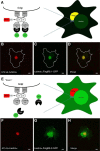
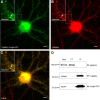



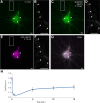
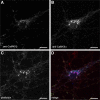
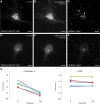

Similar articles
-
Spatiotemporal maps of CaMKII in dendritic spines.J Comput Neurosci. 2012 Aug;33(1):123-39. doi: 10.1007/s10827-011-0377-1. Epub 2012 Jan 5. J Comput Neurosci. 2012. PMID: 22218920
-
Activity-dependent modulation of the interaction between CaMKIIα and Abi1 and its involvement in spine maturation.J Neurosci. 2012 Sep 19;32(38):13177-88. doi: 10.1523/JNEUROSCI.2257-12.2012. J Neurosci. 2012. PMID: 22993434 Free PMC article.
-
Non-canonical heterogeneous cellular distribution and co-localization of CaMKIIα and CaMKIIβ in the spinal superficial dorsal horn.Brain Struct Funct. 2018 Apr;223(3):1437-1457. doi: 10.1007/s00429-017-1566-0. Epub 2017 Nov 18. Brain Struct Funct. 2018. PMID: 29151114 Free PMC article.
-
Multiple domains in the C-terminus of NMDA receptor GluN2B subunit contribute to neuronal death following in vitro ischemia.Neurobiol Dis. 2016 May;89:223-34. doi: 10.1016/j.nbd.2015.11.007. Epub 2015 Nov 12. Neurobiol Dis. 2016. PMID: 26581639
-
Developmental changes in NMDA receptor glycine affinity and ifenprodil sensitivity reveal three distinct populations of NMDA receptors in individual rat cortical neurons.J Neurosci. 1998 Mar 15;18(6):1935-43. doi: 10.1523/JNEUROSCI.18-06-01935.1998. J Neurosci. 1998. PMID: 9482779 Free PMC article. Review.
Cited by
-
DAPK1 Mediates LTD by Making CaMKII/GluN2B Binding LTP Specific.Cell Rep. 2017 Jun 13;19(11):2231-2243. doi: 10.1016/j.celrep.2017.05.068. Cell Rep. 2017. PMID: 28614711 Free PMC article.
-
Conserved and divergent features of neuronal CaMKII holoenzyme structure, function, and high-order assembly.Cell Rep. 2021 Dec 28;37(13):110168. doi: 10.1016/j.celrep.2021.110168. Cell Rep. 2021. PMID: 34965414 Free PMC article.
-
An E3-ligase-based method for ablating inhibitory synapses.Nat Methods. 2016 Aug;13(8):673-8. doi: 10.1038/nmeth.3894. Epub 2016 Jun 6. Nat Methods. 2016. PMID: 27271196 Free PMC article.
-
Discs large 1 controls daughter-cell polarity after cytokinesis in vertebrate morphogenesis.Proc Natl Acad Sci U S A. 2018 Nov 13;115(46):E10859-E10868. doi: 10.1073/pnas.1713959115. Epub 2018 Oct 30. Proc Natl Acad Sci U S A. 2018. PMID: 30377270 Free PMC article.
-
Directing evolution of novel ligands by mRNA display.Chem Soc Rev. 2021 Aug 21;50(16):9055-9103. doi: 10.1039/d1cs00160d. Epub 2021 Jun 24. Chem Soc Rev. 2021. PMID: 34165126 Free PMC article. Review.
References
Publication types
MeSH terms
Substances
Grants and funding
LinkOut - more resources
Full Text Sources
Other Literature Sources
Miscellaneous
